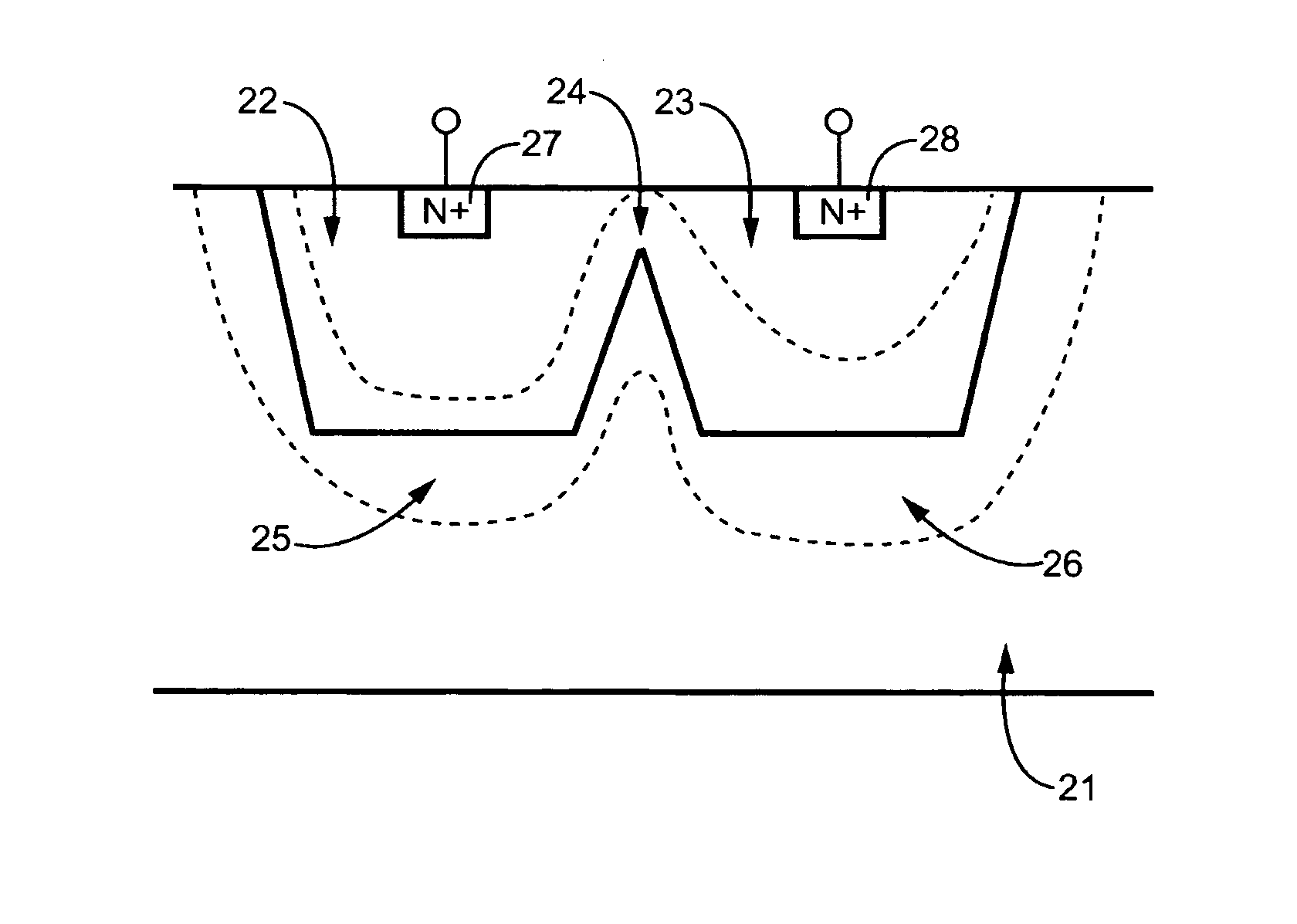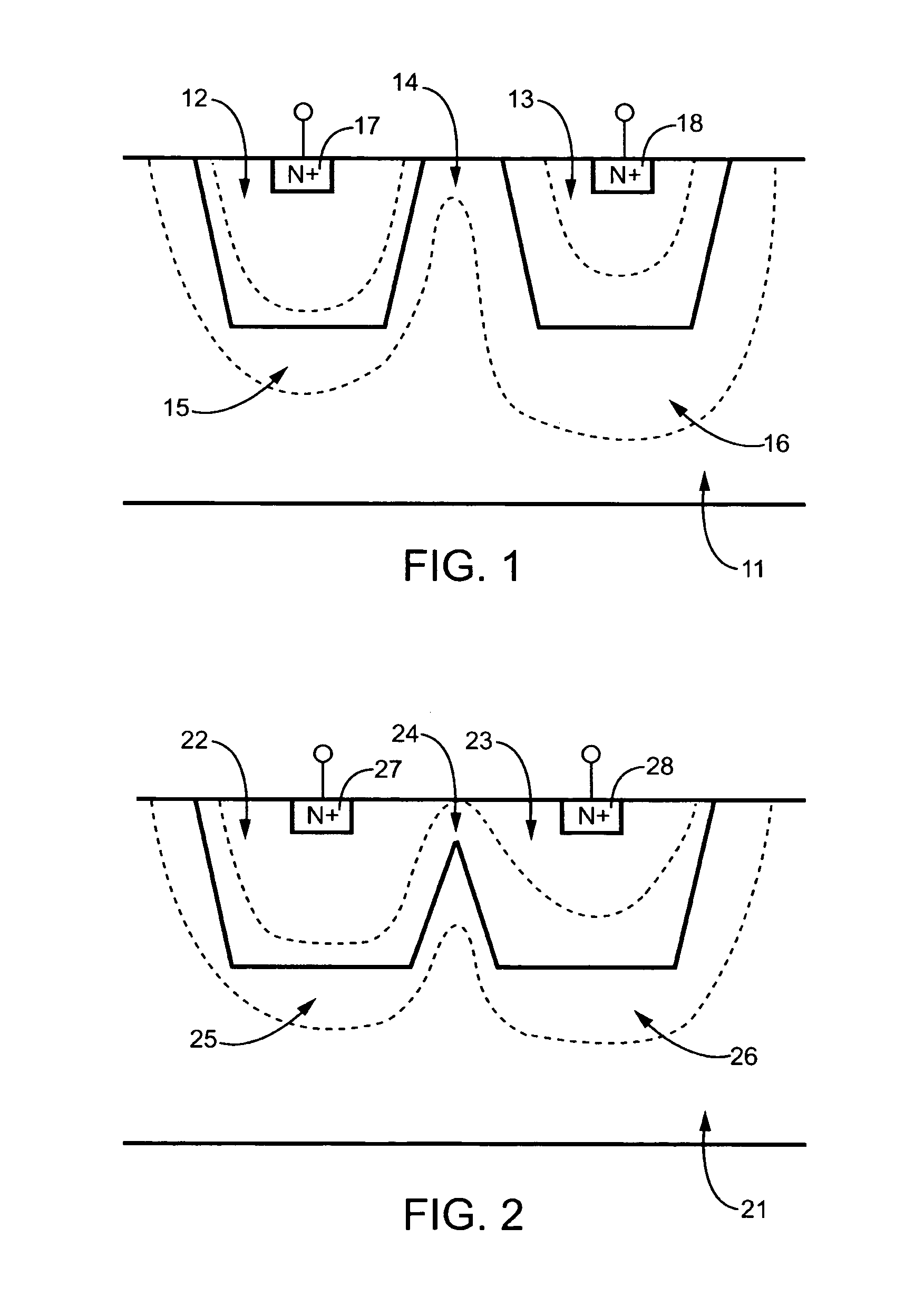Voltage-controlled semiconductor structure, resistor, and manufacturing processes thereof
a voltage-controlled semiconductor and resistor technology, applied in the direction of semiconductor devices, diodes, electrical devices, etc., can solve the problems of large cost, large size of resultant resistors, and drawbacks of using additional masks and processes
- Summary
- Abstract
- Description
- Claims
- Application Information
AI Technical Summary
Benefits of technology
Problems solved by technology
Method used
Image
Examples
first embodiment
[0021]FIG. 1 illustrates the present invention, which is a voltage-controlled resistor. The resistor comprises a P-substrate 11 and two deep N-wells 12 and 13. There are two N+ regions 17 and 18 formed in the two deep N-wells 12 and 13 respectively as terminals of the resistor. The two deep N-wells 12 and 13 are formed in the P-substrate 11 and are split. An equivalent resistor 14 is formed between the two deep N-wells 12 and 13. The depletion region 15 is formed by the first deep N-well 12 and the P-substrate 11, and boundaries of the depletion region 15 are presented by two dashed lines. Similarly, the depletion region 16 is formed by the second deep N-well 13 and the P-substrate 11, and boundaries of the depletion region 15 are presented by two dashed lines. The two depletion regions 15 and 16 are connected.
[0022]A differential voltage is applied on the resistor via the N+ regions 17 and 18, causing a reverse bias between the P-type doped region, such as the P-substrate 11, and t...
second embodiment
[0026]A differential voltage is applied on the resistor via the N+ regions 27 and 28, causing a reverse bias between the P-substrate 21, and the N-wells 22 and 23. The reverse bias affects the depletion region along with junction of the P-type doped region and the N-type doped region, and the differential thus controls electrical characters of the depletion region. In the second embodiment, a resistivity of the resistor is mainly determined by a resistivity of the equivalent resistor 24 and substantially increases after the differential voltage applied at the N+ regions 27 and 28 increases and results in pinch-off around the quasi-link region. When pinch-off occurs, connection of the N-wells 27 and 28 around the quasi-link region is interrupted by the depletion regions 25 and 26, and ions flowing through the equivalent resistor 24 dramatically decrease, which results in increase of the resistivity. The mechanism is controlled by the applied differential voltage, which achieves a vol...
fourth embodiment
[0030]the present invention is a semiconductor process for forming a semiconductor resistor with high resistivity. The corresponding flowchart is illustrated in FIG. 3. First, step 31 is executed to form two deep wells in a substrate with complementary ions, wherein depletion regions respectively formed by the two doped wells and the substrate are connected. The step 31 further comprises thermal driving for 6 to 12 hours under 1000 to 1200 degrees of Celsius. Then, step 32 is executed to form an oxide layer. Step 33 is executed to form a heavy-doped region in each of the deep wells. Finally, step 34 is executed to form two conducting ends connected the heavy-doped regions with conductive material.
[0031]Alternatively, the heavy-doped region may be formed before the deep well being formed. That is, step 31 can be executed posterior to step 33. Moreover, the sequence of the aforementioned steps is for the purpose of an example. The sequence is not intended to be a limitation of the pre...
PUM
 Login to View More
Login to View More Abstract
Description
Claims
Application Information
 Login to View More
Login to View More - R&D
- Intellectual Property
- Life Sciences
- Materials
- Tech Scout
- Unparalleled Data Quality
- Higher Quality Content
- 60% Fewer Hallucinations
Browse by: Latest US Patents, China's latest patents, Technical Efficacy Thesaurus, Application Domain, Technology Topic, Popular Technical Reports.
© 2025 PatSnap. All rights reserved.Legal|Privacy policy|Modern Slavery Act Transparency Statement|Sitemap|About US| Contact US: help@patsnap.com



